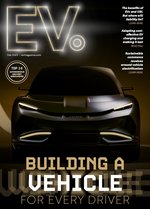How do autonomous vehicles fit into the US EV action plan?

You don’t necessarily have to look at studies to determine the scale of the US automotive influence. With major innovators born in the country and plenty more organisations looking to enter, there’s no doubt that the states are being watched for their actions to adopt electric vehicles (EVs) and charging infrastructure.
In 2023, the revenue of the passenger car industry is expected to reach more than US$553bn and present a compound annual growth rate (CAGR) of 1.38% over the next few years. A large percentage of this revenue will come from the sale of SUVs—largely due to the increase in size of all-electric cars.
The Biden-Harris Administration is also certain of its influence and has mapped out the country’s trajectory towards a fully electric transportation system, of which the country expects to eliminate half of the internal combustion engine (ICE) vehicle sales by 2030.
We also note that the US government is supporting the industry through its Electric Vehicle Charging Action Plan, which has set aside funds of US$5bn to facilitate such a shift in mobility. As a result, not only will its economy significantly reduce its reliance on ICE sales, but also plans to adopt a network of 500,000 chargers to power all of the new electrified cars.
But there are a multitude of aspects to consider and while range anxiety is most likely high on the agenda, localised transport is also a major focus for the country, which is why we want to talk about autonomous-electric vehicles (A-EVs).
Autonomous vehicles could provide major efficiencies
Many changes are bound to take effect in the coming years. In fact, the country has already seen its first flurry of autonomous automotive triumph in Las Vegas—just a couple of months ago.
It was none other than the world-renowned ride-hailing giant, Uber, that launched a self-driving ride sharing programme in partnership with Motional and Hyundai, which marks a critical milestone in autonomy, but also provides emission-reduction benefits for the city.
This is what we envisage when listening to the US Government's plans to encourage localised electric mobility. As cars are already more than capable of managing short trips to and from the shops, gym or work—depending on how close the driver lives—so the most logical solution to focus on next is self-driving cars.
And it could happen much faster than we realise. Particularly when more and more original equipment manufacturers (OEMs) are turning their attention towards autonomous solutions, such as lidar, radar, and other artificial intelligence (AI) driven systems. But one of the most crucial stories that we see evolving over the next few months is that of the Amazon-owned self-driving vehicle business, Zoox.
The online retailer has been fast-approaching driverless technology, first through its smaller delivery models, and has now released a self-driving fleet of electrified vehicles onto the streets of California.
This marks a glimpse into the future of local transportation, and one that is exciting for many reasons, including:
- It emphasises the use of EVs for local transportation
- It encourages efficiency and computer-driven cars are capable of monitoring and optimising energy consumption and charging regime
- Optimising routes and charging will ultimately reduce the cost of running and using ride-hailing services and fulfilling deliveries
- Safer transport for individuals and groups
- Minimal or no human intervention required (once autonomous vehicles and tried, tested, and fully operational
As mobility becomes a concern, particularly in some rural areas, autonomous vehicles will also provide more independence for those with minimal travel options.
- Voltpost Secures Grants for Nationwide Lamppost EV ChargersCharging & Infrastructure
- San Francisco Expands Curbside EV Charging ProgrammeCharging & Infrastructure
- How Amazon hit one Billion Electric Deliveries in the USFleet & Commercial
- Antimony Crisis: Challenges & Opportunities for EVsTechnology



